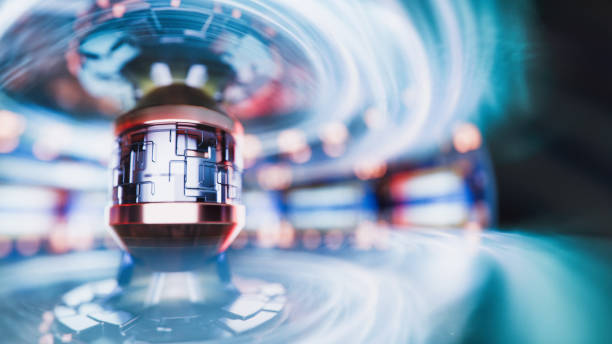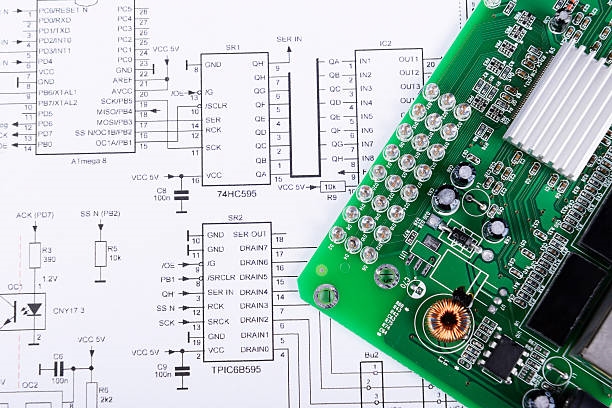Hertz's Experiments and First Detection
After Maxwell established the theory of electromagnetism, a young experimental physicist in Berlin named Heinrich Hertz (1857-1894) completed the experimental work in 1888. Many people admired Maxwell's elegant description of electromagnetic waves but could not find them experimentally. The 26-year-old Hertz used a clever setup: he positioned two small metal spheres with a small gap between them and applied a high-voltage discharge. Although the spheres were not connected, a sharp crackling sound appeared between them and blue sparks jumped across the gap. Obviously an electric field was present between the spheres. According to Maxwell's equations, an oscillating electric field should excite a magnetic field, which in turn excites an electric field, and this coupled oscillation propagates outward as electromagnetic waves. To confirm this, a receiver was needed. Hertz placed a copper ring with a gap about four meters away from the transmitting spheres. If electromagnetic waves reached the ring, sparks should also jump across the gap in the ring. When he pressed a switch at the transmitter, faint blue flashes appeared at the gap in the ring, indicating that electromagnetic waves were indeed propagating between the transmitter and receiver.
Because it was a wave, it should have a wavelength, frequency, and speed. Hertz set out to measure the wavelength. He moved the copper ring closer to the transmitting spheres; the spark brightness varied, with the brightest moments corresponding to wave peaks or troughs and the dark moments to zeros. From this he deduced the wavelength and then calculated a propagation speed of about 300,000 km/s, equal to the speed of light. He also observed reflection and refraction similar to light. Maxwell's theory was thus fully confirmed. From Faraday to Maxwell and then to Hertz, two experimental physicists and one theoretical physicist complemented one another to complete this major discovery.
Hertz's Habits and Education
Why did Hertz achieve this? Many reasons could be offered, but two factors from his student years stand out. First, he developed a habit of hands-on work from an early age and enjoyed learning technical skills. In his spare time he apprenticed with a carpenter, becoming proficient with the saw, plane, axe, and chisel. He also learned lathe work; later his lathe master, upon hearing that Hertz had become a university professor, lamented to Hertz's mother: "What a pity! He would have made a rare lathe machinist." Manual skill and diligence often correlate with practical ingenuity. Second, Hertz had broad interests. He studied English, French, and Italian, and showed remarkable aptitude for Arabic, to the point that a teacher seriously suggested he study Oriental languages. He loved art and drew well, which trained his visual imagination. He enjoyed mathematics and often participated in math contests, which trained his logical thinking. He considered architecture and studied it for a time, and he served in the military, which gave him endurance and disciplined routine. In a letter to his parents he wrote, "Laziness has truly been banished from me." Many readers will include young people eager to develop—these brief notes on Hertz's path may offer some inspiration.
Hertz's Death and an Obituary
Hertz's discovery of electromagnetic waves came at a youthfulness comparable to Newton discovering gravity or to Davy isolating potassium and sodium—many such discoveries were made by people in their twenties. However, from 1893 he suffered from a persistent gum abscess. Although not life-threatening, it was stubborn and only temporary relief came from multiple surgeries. He became melancholic and sensed his life was short. On the night of December 4, 1893, by lamplight, he wrote to his parents a letter that was both consolation and forecast: "If anything should happen to me, you should not be sorrowful but rather feel some pride and think that I belong to those whose life, though brief, has been quite fruitful. I do not desire or choose such a fate, but since it has befallen me I must accept it with satisfaction." The world is indeed unfair: many insignificant people live to old age while contributors like Hertz died suddenly. In January 1894 he passed away at the age of 37, which caused deep mourning in the European physics community. The day after his death, an obituary posted at the University of Padua read:
"Professor Hertz of Bonn University unfortunately passed away yesterday. A star of physics has suddenly fallen; this is a loss for all Europe. Professor Hertz's greatest contribution to humanity is that his experiments finally detected electromagnetic waves. He was German, but he told the Italians and the whole world that electromagnetic waves are all around us and can be transmitted and received. Though he is gone, the waves he revealed will remain forever and accompany us. Thus Professor Hertz belongs to the whole world; Professor Hertz is not dead; he lives among us... To express respect and mourning for this world-renowned man, a solemn memorial service will be held tomorrow morning in the university auditorium."
...
Marconi Reads the Obituary
Under that obituary, some people glanced and hurried away, some sighed, but one young man stood as if nailed to the spot. His eyes fixed on the notice, lips slightly parted, he remained silent for a long time with a pensive, sorrowful expression. He stood there for about an hour, reluctant to leave. Who was this young man? It was Guglielmo Marconi (1874-1937), born into a well-to-do family in Padua. He had a strong habit of diligent study and independent thinking. Readers who study generally fall into two types: one is the "book-sack" who dutifully reads textbooks but does not digest or create from them; the other is a "book-awl" who probes texts with why and how, extracts insights, and can apply thinking to new problems. Marconi belonged to the second type. From this single obituary he drew an idea: if Hertz's waves existed in Germany and Italy, why not use these invisible waves to transmit signals and human intent, making dead waves alive? If achieved, Hertz's achievement would be made more enduring. To honor the dead is to advance their work and do something for the living. Marconi went home and told his father, "I have a feeling these waves will soon provide humanity with a new and powerful means of communication."
Early Experiments and Setbacks
After reading the obituary, Marconi immediately collected information and set up an antenna and ground connection at his father's villa. He experimented day and night and improved the detector, eventually building transmitter and receiver. He achieved the first communication between his home and a location 17 kilometers away in the hills. Overjoyed, he wrote to the Italian postal and telegraph department seeking funding and offering to contribute his invention to national communications. His letter was ignored, so he turned to Britain to apply for patents.
In 1896 in London a young man carrying a large box was about to disembark when customs officers stopped him because he looked disheveled and nervous. The young man was Marconi. Stammering, he explained that the box contained a wireless telegraph. Customs officers, unfamiliar with such a device, rifled through the box and examined him. One officer speculated, "Maybe it's a bomb." Alarmed, another officer threw the box overboard and pushed Marconi off the ship, ordering him to leave.
Marconi, robbed of his equipment and alone in a foreign city, decided to go to the Post Office building seeking assistance. The chief engineer of the Post Office, Preece, was a kindly, talent-friendly man. He had already seen Marconi's patent application in an electrical journal and had been looking for him. When Preece learned Marconi was the visitor, he embraced the young man. Marconi, overcome with relief at meeting someone who understood his work, burst into tears and explained the box had sunk. Preece laughed and said, "Child, with you here we have everything. The equipment in this building is at your disposal; shall we not rebuild that box?" Marconi could hardly believe his ears and soon began to rebuild the transmitter and receiver. With Preece's support, he quickly achieved communication between the top of the Post Office building and a bank building about 3,000 meters away.
Public Demonstration and Wider Acceptance
Soon after, a yacht race provided an opportunity to demonstrate wireless telegraphy. The start was at the harbor and the finish 15 kilometers out at sea. Previously, race results often took hours to reach shore, leaving spectators and bettors anxious. To test and publicize the new communication system, the Post Office arranged two green mailboats: Preece would transmit from the finish and Marconi would receive at the start. At the starting gun, amid horns, drums, and cheering, the yachts sped away. A short while later, when the crowd relaxed, Marconi suddenly jumped up and shouted, "Mary is first! Mary has won!" Some bettors believed him, others accused him of lying and an argument erupted. Moments later a launch returned from the course confirming the result. The crowd then accepted that the small transmitting device truly had the power of long-distance sensing. Spectators cheered, carried Marconi aloft, inspected the device, and in the exuberant confusion someone momentarily tossed him into the water. The scene ended in laughter.
Crossing the Atlantic and Legacy
By 1898 radio waves had crossed the English Channel and were in commercial use. In February 1901 Marconi erected a 170-foot radio transmitting tower in Cornwall, and then, accompanied by his assistants Kemp and Peki, he went to Liverpool to board a ship bound for Newfoundland to attempt reception of the Cornwall station's signals. It was midwinter with strong winds and rough seas; thin ice covered the deck. His father and respected teacher came to see him off and urged him not to risk the voyage.
"Son, I'm not trying to hold you back," his father said, "radio waves can cross the 45-kilometer English Channel, but they will never cross the Atlantic. Even the strongest waves decay in the air." His teacher added that Hertz himself believed electromagnetic waves traveled in straight lines like light and would not reach beyond the Earth's curvature without a distant mirror to reflect them.
Marconi replied, "Things must be tried. Who could have believed magnetic influence could be transformed into electricity? Faraday tried, and Maxwell summarized; reason and experiment together proved it. Whether it succeeds or fails, I will try, and even failure will provide experimental data for future workers." With that he boarded the ship.
On December 12 Marconi and two assistants arrived at a small hill facing the Atlantic in Newfoundland. They installed a receiver in a clock tower and raised a large hexagonal kite carrying a wire antenna to about 400 meters, an ingenious method to obtain height for the antenna. With everything in place, Marconi put the earpiece to his ear and listened. Outside, one assistant handled the kite; inside, the other assistant watched the receiver closely. Suddenly three short ticks appeared: "di—di—di." Marconi at first thought it was his heartbeat. He pressed the earpiece to his assistant Kemp's ear and said, "Listen, is that the signal?" Kemp listened for a few seconds and then shouted, "Three short pulses, they are sending! We have succeeded!"
The radio signal had traveled about 3,700 kilometers, building the first communication bridge across the Atlantic. Newspapers around the world reported the astonishing news. In 1909 Marconi received the Nobel Prize for this achievement.
 ALLPCB
ALLPCB








